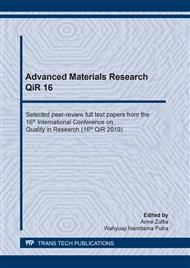[1]
M. Mohapatra and S. Anand, Synthesis and applications of nano-structured iron oxides/hydroxides – a review, Int J Eng Sci. 2 (2010) 127-146.
Google Scholar
[2]
M. Arruebo, F.R. Pacheco, R.M. Ibarra and J. Santamaría, Magnetics nanoparticles for drug delivery, Nanotoday. 2 (2007) 22-32.
Google Scholar
[3]
S. Mukarami, T. Hosono, B. Jeyadevan, M. Kamitakahara and K. Ioku, Hydrothermal synthesis of magnetite/hydroxyapatite composite material for hypetermia therapy for bone cancer, J CERAM SOC JPN. 116 (2008) 950-954.
DOI: 10.2109/jcersj2.116.950
Google Scholar
[4]
F. Gao, Y. Cai, J. Zhou, X. Xie, W. Ouyang, Y. Zhang, X. Wang, X. Zhang, X. Wang, L. Zhao and J. Tang, Pullulan acetate coated magnetite nanoparticles for hyper-thermia: preparation, characterization and in Vitro experiments, Nano Res. 3(2010) 23–31.
DOI: 10.1007/s12274-010-1004-6
Google Scholar
[5]
E. M. Alfsen, F.C. Stormer, A. Nja and L. Walloe, A proposed tandem mechanism for memory storage in neuronsinvolving magnetite and prions, Med. Hypotheses. 119 (2018) 98-101.
DOI: 10.1016/j.mehy.2018.07.003
Google Scholar
[6]
K.S. Loh, Y.H. Lee, H. Musa, A.Z. Salmah and I. Zamri, Use of Fe3O4 nanoparticles for enhancement of biosensor response to the herbicide 2,4-dichlorophenoxyacetic acid, Sensors. 8 (2008) 5775-5791.
DOI: 10.3390/s8095775
Google Scholar
[7]
L. Giraldo, A. Erto and J. C. M. Pirajan, Magnetite nanoparticles for removal of heavy metals from aqueous solutions: synthesis and characterization, Adsorption. 19 (2013) 465-474.
DOI: 10.1007/s10450-012-9468-1
Google Scholar
[8]
A. El-Nasr, H.M. El-Hennawy, M.H. El-Kereamy, A. El-Yazid and A.S. Eldin, Effect of magnetite nanoparticles (Fe3O4) as nutritive supplement on pear saplings, J. Middle East appl. sci. technol. 05 (2015) 777-785.
Google Scholar
[9]
X. Sun, K. Sun and Y. Liang, Hydrothermal synthesis of magnetite: investigation of influence of aging time and Mechanism, MICRO NANO LETT. 10 (2015) 99–104.
DOI: 10.1049/mnl.2014.0344
Google Scholar
[10]
W. Cheng, K. Tang, Y. Qi, J. Sheng and Z. Liu, One-step synthesis of superparamagnetic monodisperse porous Fe3O4 hollow Sphere, J. Mater. Chem. 2 (2010) 1799–1805.
DOI: 10.1039/b919164j
Google Scholar
[11]
A. Fadli, A. Amri, E. O. Sari, Iwantono and A. Adnan. Crystal-growth kinetics of magnetite (Fe3O4) nanoparticles using the Ostwald ripening model, Int. J. Technol. 8 (2017) 1445-1454.
DOI: 10.14716/ijtech.v8i8.738
Google Scholar
[12]
X. Cao, B. Zhang, F. Zhao and L. Feng, Synthesis and Properties of MPEG-Coated Superparamagnetic Magnetite Nanoparticles, J Nanomater. 607296 (2012) 1-6.
Google Scholar
[13]
M. Yu, S. Huang, K. J. Yu, and A. M. Clyne, Dextran and Polymer Polyethylene Glycol (PEG) Coating Reduce Both 5 and 30 nm Iron Oxide Nanoparticle Cytotoxicity in 2D and 3D Cell Culture, Int J Mol Sci. 13 (2012) 5554-5570.
DOI: 10.3390/ijms13055554
Google Scholar
[14]
A.G. Kolhatkar, A.C. Jamison, D. Litvinov, R.C. Willson and T.R. Lee, Tuning the Magnetic Properties of Nanoparticles, Int J Mol Sci. 14 (2013) 15977-16009.
DOI: 10.3390/ijms140815977
Google Scholar
[15]
T. Horikawa, D.D. Do and D. Nicholson, Capillary condensation of adsorbates in porous materials, Adv. Colloid Interface Sci. 169 (2011) 40-48.
DOI: 10.1016/j.cis.2011.08.003
Google Scholar
[16]
E.O. Sari, A. Fadli and A. Amri, The 3 hours-hydrothermal synthesis of high surface area superparamagnetic Fe3O4 core-shell nanoparticles, Indonesian Journal of Materials Science. 19 (2017)1-6.
DOI: 10.17146/jsmi.2017.19.1.4111
Google Scholar


